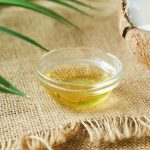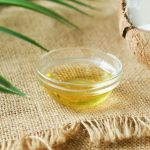First, gently blot the excess coconut oil without rubbing to avoid spreading. Sprinkle baking soda or cornstarch on the stain to absorb the oil and let it sit for 15-30 minutes. Next, apply grease-fighting dish soap directly on the spot and work it in, leaving it for 5-10 minutes. Wash the garment in the warmest water safe for the fabric, then air dry to prevent setting the stain. Follow these steps, and you’ll find even more tips to fully restore your clothing.
Table of Contents
Key Takeaways
- Blot excess coconut oil gently with a dry cloth without rubbing to avoid spreading the stain.
- Sprinkle baking soda or cornstarch on the stain and let it absorb oil for 15-30 minutes.
- Apply grease-fighting dish soap directly to the stain, work it in, and rinse with warm water.
- Pre-treat stubborn stains with a stain remover designed for grease before washing.
- Wash garment in the warmest water safe for the fabric and air dry to prevent setting the stain.
Identify the Coconut Oil Stain on Your Clothing
When you spot a greasy, translucent patch on your clothing, you’re likely dealing with a coconut oil stain. These stains usually appear shiny and may feel slightly slippery or sticky to the touch, especially if the oil hasn’t fully soaked in.
Since coconut oil melts at around 76°F (24°C), it can be solid or liquid depending on the temperature. Check areas where you might’ve applied coconut oil or where it could have spilled, like collars, sleeves, or pockets.
The stain might look darker on light fabrics or leave a subtle sheen on darker materials. Being able to correctly identify the coconut oil stain helps you choose the right treatment method quickly, preventing the stain from setting and becoming harder to remove.
Gently Blot Excess Oil Without Spreading
After spotting the oily patch, your next step is to carefully blot away any excess coconut oil.
Use a clean, dry cloth or paper towel and gently press it onto the stain. Don’t rub or wipe, as this will just spread the oil further into the fabric. Instead, apply light, steady pressure to lift as much oil as possible.
Rotate to a clean area of the cloth frequently to avoid re-depositing oil back onto the garment. Work from the outside edges of the stain toward the center to prevent it from expanding.
Taking your time here is key—blot patiently until you’ve removed most of the surface oil. Once done, you’ll be ready to move on to the next step in treating the stain effectively.
Apply Baking Soda or Cornstarch to Absorb Oil
Although blotting removes much of the surface oil, some residue often remains embedded in the fabric. To tackle this, sprinkle a generous amount of baking soda or cornstarch directly onto the stained area.
Blotting removes surface oil, but baking soda or cornstarch helps lift embedded residue from fabric.
These powders act like magnets, drawing out the oil from the fibers. Let it sit for at least 15 to 30 minutes—longer if the stain is stubborn. As the powder absorbs the oil, you’ll notice it clumping together or darkening.
Once the waiting time is up, gently brush or shake off the powder. Avoid rubbing, as that can push the oil deeper. This step considerably reduces the grease, setting you up for easier removal in the next cleaning phases.
Make sure to treat the stain promptly for best results.
Use Dish Soap to Break Down the Grease
You’ll want to pick a dish soap that’s designed to cut through grease for the best results.
Apply it directly to the stain, gently working it in to break down the coconut oil.
After rinsing, repeat the process as needed until the stain fades.
Choosing the Right Soap
One effective way to tackle coconut oil stains is by choosing the right soap, and dish soap is a top choice because it’s designed to cut through grease.
When selecting dish soap, look for formulas labeled “grease-fighting” or “degreaser” since they contain ingredients that break down oil molecules effectively.
Avoid mild soaps or those meant only for sensitive skin, as they may not be strong enough to remove stubborn coconut oil stains.
You can also check the ingredients list for surfactants like sodium lauryl sulfate, which help lift and dissolve grease.
Using a quality dish soap guarantees you’re attacking the stain at its source, making your cleaning efforts much more efficient and increasing the chances of restoring your clothing to its original state.
Applying Soap Effectively
After selecting a grease-fighting dish soap, it’s time to apply it correctly to break down the coconut oil stain.
First, place the stained area on a flat surface and gently blot any excess oil with a paper towel—don’t rub, or you could spread the stain.
Next, pour a small amount of dish soap directly onto the stain. Using your fingers or a soft-bristled toothbrush, work the soap into the fabric with gentle circular motions. This helps the soap penetrate the fibers and emulsify the oil.
Let the soap sit on the stain for about 5 to 10 minutes to maximize its grease-cutting power. Avoid letting the soap dry out completely, as this can reduce effectiveness.
This targeted approach prepares the fabric for thorough rinsing and cleaning.
Rinsing and Repeating
Although the dish soap starts breaking down the coconut oil, rinsing the fabric thoroughly with warm water is essential to remove loosened grease and soap residue.
After rinsing, check the stain; if it’s still visible, repeat the soap application and rinsing steps. Persistence is key to fully removing the oily mark without damaging your clothing.
Here’s how to effectively rinse and repeat:
- Use warm water to help dissolve grease.
- Gently rub the fabric to release trapped oil.
- Avoid hot water, which can set the stain.
- Repeat the dish soap application if needed before the final rinse.
Pre-Treat the Stain With a Stain Remover
You’ll want to pick a stain remover that targets grease effectively to tackle coconut oil.
Apply it directly to the stain, making sure to cover the entire affected area.
Then, let it sit for a few minutes to break down the oil before washing.
Choosing Effective Stain Removers
When tackling coconut oil stains, selecting the right stain remover can make all the difference in how effectively you lift the oil from your clothing. You want a product that targets greasy residues without damaging your fabric.
Look for stain removers with these qualities:
- Enzymatic formulas that break down oil molecules
- Solvent-based removers designed for tough grease
- Gentle ingredients safe for delicate fabrics
- Products with clear instructions for oil stains
Avoid generic cleaners that don’t specify effectiveness on oils.
Also, check for any fabric-specific warnings to prevent discoloration or damage. By choosing a stain remover tailored to greasy stains, you increase your chances of fully eliminating the coconut oil and restoring your clothing’s appearance.
Application Techniques for Stain Removal
Choosing the right stain remover sets you up for success, but applying it correctly is just as important. First, gently blot excess oil without rubbing. Then, apply the remover directly onto the stain for targeted treatment. Use a soft brush or your fingers to work it into the fabric fibers evenly, ensuring full coverage without damaging the material. Avoid using too much remover to prevent residue.
| Step | Action | Tips |
|---|---|---|
| 1 | Blot excess oil | Use a clean cloth, no rubbing |
| 2 | Apply stain remover | Target stain directly |
| 3 | Work remover into fabric | Use soft brush or fingers |
| 4 | Avoid over-saturating fabric | Prevent residue buildup |
This method maximizes stain removal efficiency before washing.
Letting Remover Sit
Allow the stain remover to sit on the fabric for at least 10 to 15 minutes to break down the coconut oil effectively. This waiting period gives the remover time to penetrate and dissolve the oily residue.
Avoid rushing this step to guarantee the best results. While the remover works, you can prepare for the next steps or check the stain’s progress.
Keep these tips in mind:
- Don’t let the remover dry completely; keep it moist for better action.
- Check fabric care labels to avoid damage.
- For stubborn stains, you can gently blot the area after sitting time.
- Avoid rubbing aggressively, as it can spread the oil further.
Following this step carefully boosts your chances of a clean, oil-free garment.
Wash the Garment in the Warmest Water Safe for Fabric
Select the warmest water temperature that your fabric can handle to effectively break down the coconut oil residue. Hot water works best on durable fabrics like cotton, while delicate materials require cooler settings to avoid damage. Check your garment’s care label before washing. Use a good quality laundry detergent designed for grease removal to maximize oil breakdown. Wash the garment separately or with similar fabrics to prevent spreading the residue.
| Fabric Type | Recommended Water Temperature |
|---|---|
| Cotton | Hot (120°F / 49°C) |
| Polyester | Warm (90°F / 32°C) |
| Silk/Wool | Cold (60°F / 15°C) |
Air Dry and Inspect for Remaining Stains
Once the wash cycle is complete, air drying your garment helps prevent any remaining coconut oil stains from setting in.
Avoid using the dryer until you’re sure the stain is gone, as heat can make it permanent. Hang your clothing in a well-ventilated area and let it dry completely.
After drying, inspect the fabric carefully under good lighting.
If you still notice any stains, you can:
- Reapply a stain remover or dish soap directly on the spot
- Gently rub the fabric together to work the solution in
- Let it sit for 10-15 minutes before rewashing
- Repeat the air dry and inspection process
This method guarantees you only dry your clothing when the stain is fully treated.
Frequently Asked Questions
Can Coconut Oil Stains Damage Delicate Fabrics Like Silk or Wool?
Yes, coconut oil stains can damage delicate fabrics like silk or wool if not treated quickly. You’ll want to act fast because the oil may weaken fibers or cause discoloration, making careful cleaning essential.
Is It Safe to Use Hot Water on All Clothing Types to Remove Oil?
You might think hot water can melt your clothes like lava, but it’s not safe for all fabrics. You shouldn’t use hot water on delicate materials like silk or wool; stick to cool or lukewarm instead!
How Long Should I Wait Before Treating a Fresh Coconut Oil Stain?
You shouldn’t wait long—treat a fresh coconut oil stain as soon as possible. The quicker you act, the better your chances of preventing the oil from setting into the fabric, making removal easier.
Can Coconut Oil Stains Be Removed After the Garment Has Been Dried?
You might think dried coconut oil stains are permanent, like ancient cave paintings, but don’t give up! You can still tackle them with hot water and detergent. Just act fast and scrub thoroughly to improve your chances.
Are There Natural Alternatives to Dish Soap for Removing Oil Stains?
You can use natural alternatives like baking soda, white vinegar, or lemon juice to remove oil stains. These ingredients break down grease effectively, so don’t hesitate to try them if you want a chemical-free solution.
- A Deep Dive: The Fabrication of Tender Coconut Cutting Machines - June 30, 2025
- What Makes Coconut Fabric Rash Guards a Good Choice for Swimmers? - June 30, 2025
- How to Sew With Coconut Print Fabric: Tips and Tricks - June 30, 2025







